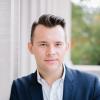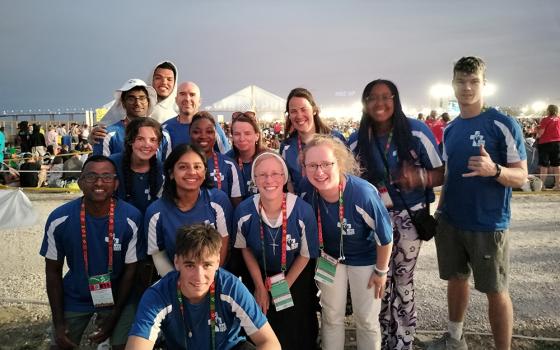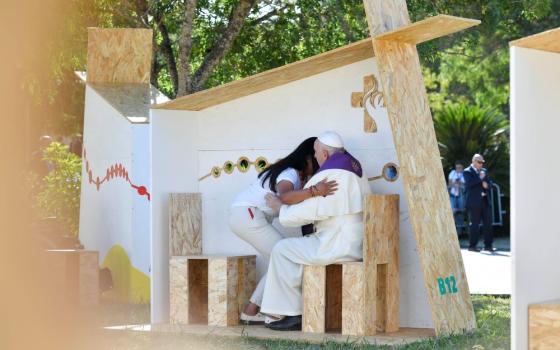Pope Francis prays the rosary in the Chapel of the Apparitions at the Shrine of Our Lady of Fátima in Fátima, Portugal, Aug. 5. (CNS/Vatican Media)
During an Aug. 5 visit to one of the Catholic Church's most storied Marian shrines — a place where for over a century spirituality and geopolitics have been elaborately intertwined — Pope Francis sidestepped one of the most glaring issues facing the world today, bypassing a much anticipated occasion to appeal for peace in Ukraine.
Instead, the pope used his visit to encourage some 200,000 pilgrims here for the visit to follow the example of Mary in modeling a church open to everyone — a theme he has repeated daily during his Aug. 2-6 visit to Portugal for World Youth Day.
While the pope never mentioned Ukraine or Russia by name during his three-hour visit to Fátima — where, in 1917, the Virgin Mary reportedly made several appearances to three shepherd children and asked them to pray for peace in the midst of World War One — the raging war in Europe loomed large over the pope's visit.
As the pope prayed the rosary, balloons with the letters P-A-C-E ("peace") flew above the crowds. Ahead of the pope's unscripted remarks, Bishop José Ornelas Carvalho of the Leiria-Fátima Diocese said that the visitors joined Francis' prayer for peace "with which this shrine deeply identifies, with particular regard to the war in Ukraine."
The pope arrived in Portugal Aug. 2 for a five-day visit to preside over World Youth Day, a weeklong festival of Catholic young people from around the globe. A visit to the popular Marian shrine of Fátima, which draws more than a million visitors a year, was included in his itinerary, with high expectations that, due to the historical parallels at play, he would directly acknowledge the ongoing war in Ukraine.
Francis, like both Popes John Paul II and Benedict XVI, has long had a devotion to Our Lady of Fátima. In 2017, he visited the shrine to mark the centenary of the Marian apparitions, and in March 2022 — just after the start of Russia's invasion of Ukraine — Francis consecrated both nations to Mary in a special Vatican prayer service for peace.
The consecration came at the request of Ukrainian bishops, but dates back to the writings of Carmelite Sr. Lúcia dos Santos, one of the shepherd children to whom Mary appeared in 1917 and to whom the Virgin reportedly shared various "secrets" about the future.
Specifically, according to dos Santos' account, Mary shared a vision of hell and pleaded that a reigning pope consecrate Russia in the name of her Immaculate Heart so that the atheistic, communist regime might be converted.
Despite multiple popes performing the act — including Pope Francis mentioning Russia and Ukraine by name — some traditionalists have claimed that the consecration has never been performed correctly. Hence, for over 70 years, Fátima has both inspired devotion and fueled endless mysteries and conspiracy theories.
Upon arriving in the country Aug. 2, Francis used his first address to civic and diplomatic leaders to call for peace in Ukraine, urging Europe to find creative ways to work toward unity as it did after two world wars.
The pope's Aug. 5 visit to Fátima marked the third consecutive speech in which the pope scrapped his prepared remarks. Vatican spokesperson Matteo Bruni told reporters that the pope "always addresses firstly the people he meets, as a shepherd, and speaks accordingly" and later said that Francis informed him that he had prayed for peace in silence in front of the statue of Our Lady of Fátima
During his first meeting on Aug. 4, the pope acknowledged he was having trouble reading the text due to the lighting in the parish center where he met with Portuguese charity workers. Bruni said that the pope's difficulty was limited to that particular meeting and setting.
On the morning of Aug. 5, nearby mountain fires darkened the skies above, while illuminating the Fátima sanctuary in a pink glow as ash rained down on pilgrims, some of whom had camped out overnight in order to pray with the pope.
Despite the almost apocalyptic-like backdrop to the event and the pope intently praying before a statue of Our Lady of Fátima for some 20 minutes, the pope was animated while he directly addressed the crowd.
"There are many Marian invocations," the pope said, before suggesting that another way to think of Mary was as "Our Lady who sets out running."
"Every time there is a problem, every time we invoke her, she doesn't delay, she hurries," he said, before inviting the crowd to repeat the expression after him. "She hurries to be close to us. She hurries because she is a mother "
Advertisement
Among the thousands of pilgrims there — some of whom wept uncontrollably, while others cheered enthusiastically — was 46-year-old Bruno Oliveira, who was born in Fátima.
"Our Lady is our mother," he told NCR. "When you have a chance to go to the house of the mother we go, because our love is that strong."
Oliveria said that the "big issue" in today's world is that of suffering, particularly in light of the war. "When there is suffering, we pray," he said.
Anthony Hartnett, a 28-year-old seminarian from County Donegal, Ireland, who has been staying in Fátima this week with a group of Irish pilgrims attending World Youth Day, said that he knows very well the role of prayer in ending conflict.
"We have a history of turning to prayer in things like war, in order to pray for peace," he said. "I really do believe in the power of prayer and to be able to be a part of that here is something that is special and also solemn. There's a real weight to it here."
Following his visit to Fátima, Francis returned to Lisbon via helicopter, where later he was scheduled to preside over an evening vigil for pilgrims attending the final night of World Youth Day, ahead of an Aug. 6 Mass expected to draw crowds of more than a million people.





